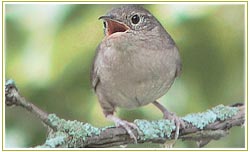About The House Wren
 The House Wren is one of the most popular songbirds in North America. It is so named for its preference for small town and suburban backyards and man-made birdhouses. It is a small brown bird with long pointed bill. Its head, nape and back are uniformly brown with dark brown stripes. Its throat and chest are light grey. It has a white eyebrow-like stripe over the eyes. Both sexes are identical in color but the male is slightly larger.
The House Wren is one of the most popular songbirds in North America. It is so named for its preference for small town and suburban backyards and man-made birdhouses. It is a small brown bird with long pointed bill. Its head, nape and back are uniformly brown with dark brown stripes. Its throat and chest are light grey. It has a white eyebrow-like stripe over the eyes. Both sexes are identical in color but the male is slightly larger.
The House Wren Nesting Preferences
House Wrens prefer to nest in cavities close to the ground with small entrances. The male begins building the nest by placing more than 400 sticks into the bottom of the cavity. When a female pairs with the male, she finishes building the nest. The nest is constructed out of twigs, sticks, and leaves. It is then lined with soft fibers and feathers arranged in a circular fashion. As many as 6 to 7 glossy pinkish eggs are laid and incubated by the female for about 12 days. The young leave the nest after 15 or 17 days within a few hours of each other. The parents continue to feed the young for another two weeks.
Click to learn more About The House Wren Nesting Preferences
Building a Birdhouse For The House Wren
 House Wrens readily accept birdhouses between 5 to 10 feet above the ground close to shrubby areas or under the eaves of buildings, along fencerows or in large trees. The birdhouse can also be left free hanging. It should be about 4 inches in width x 4 inches in length x 6 inches in height. The entrance hole should be 1 ¼ inch in diameter to keep English sparrows out. It should be located 4-7 inches above the floor.
House Wrens readily accept birdhouses between 5 to 10 feet above the ground close to shrubby areas or under the eaves of buildings, along fencerows or in large trees. The birdhouse can also be left free hanging. It should be about 4 inches in width x 4 inches in length x 6 inches in height. The entrance hole should be 1 ¼ inch in diameter to keep English sparrows out. It should be located 4-7 inches above the floor.
Click to learn more About Building a Birdhouse For The House Wren
The House Wren Mating Habits
 During breeding season, the male flutters through the air slowly and sing to attract females. A male who finds a mate often sing a “whispering” song often sung only around the time of copulation. The song is sung quietly may be to avoid revealing the location of his fertile mate to other males. The female also sings in response to her mate’s song. House Wrens are usually monogamous but the male may have more than one mate at a time. They switch breeding partners between the first and second brood of a season. Breeding pairs last only for one season.
During breeding season, the male flutters through the air slowly and sing to attract females. A male who finds a mate often sing a “whispering” song often sung only around the time of copulation. The song is sung quietly may be to avoid revealing the location of his fertile mate to other males. The female also sings in response to her mate’s song. House Wrens are usually monogamous but the male may have more than one mate at a time. They switch breeding partners between the first and second brood of a season. Breeding pairs last only for one season.
The House Wren Feeding Preferences
House Wren feed mainly on small, terrestrial insects like caterpillars, flies, spiders, beetles, grasshoppers, crickets, moths and other crawling insects.
Adults who feed their young supplement their own diet with calcium-rich foods such as mollusk shells. They glean insects from leaves and shrubs.
Click to learn more About The House Wren Feeding Preferences
Interesting House Wren Facts
The House Wren is also known as Common Wren. They hop mostly while on the ground. Male House Wrens flying to the North to breed in their first year more often than not settle close to an experienced male. The latter tend to settle farther apart. Young males gather clues from established males about areas that are good nesting sites. The House Wren has the habit of puncturing eggs of other species nesting in nest boxes. At times, it seizes other birds’ nests to breed but does not share its territory with others of its kind. It even vigorously challenges intruders near its nest. House Wrens are one of the easiest birds to attract to birdhouses in urban areas.